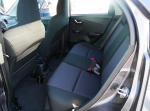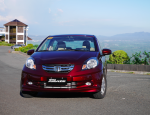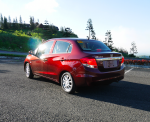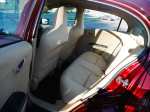 Small car fans, rejoice. Honda has taken the wraps off an A-segment vehicle that can perform well in the city and on the highway, with that proper Honda driving feel. With the City and Jazz moving up in size and price, the time is right for Honda to bring in a new hatchback and sedan to serve as its entry-level cars.
Small car fans, rejoice. Honda has taken the wraps off an A-segment vehicle that can perform well in the city and on the highway, with that proper Honda driving feel. With the City and Jazz moving up in size and price, the time is right for Honda to bring in a new hatchback and sedan to serve as its entry-level cars.
Exterior design
 The Brio hatchback is a cheerful looking car. It has a bulbous nose with ellipsoidal headlamps. A large black-painted opening sits below the bumper, incorporating foglamps and air ducting. The Honda logo in the family wing-shaped motif is mounted within a trapezoidal grille. Things get more interesting at the sides. The doors have sharp, upturned creases, and the greenhouse has an upward sweep. And then there’s the rear. The back is sharply truncated, with rear wheels right at the corners. Clear triangular taillights flank a single-piece glass hatch, ala CRX. It’s similar to the one on the Volvo C30.
The Brio hatchback is a cheerful looking car. It has a bulbous nose with ellipsoidal headlamps. A large black-painted opening sits below the bumper, incorporating foglamps and air ducting. The Honda logo in the family wing-shaped motif is mounted within a trapezoidal grille. Things get more interesting at the sides. The doors have sharp, upturned creases, and the greenhouse has an upward sweep. And then there’s the rear. The back is sharply truncated, with rear wheels right at the corners. Clear triangular taillights flank a single-piece glass hatch, ala CRX. It’s similar to the one on the Volvo C30.
 The Brio’s footprint measures 3610mm long x 1680mm wide, about 230mm shorter than the first-generation Jazz, with almost the same width.
The Brio’s footprint measures 3610mm long x 1680mm wide, about 230mm shorter than the first-generation Jazz, with almost the same width.
Thankfully, the Brio Amaze sedan doesn’t look like a hatchback with a trunk grafted on, like the first-generation City or the Swift Dzire. The Amaze has a squarish trunk, lending the sedan a more conventional three-box profile. The trunk allows for a larger cargo area of 400 liters.
Interior
 Inside is where the Brio is a cut above its rivals: namely, the Toyota Wigo and Mitsubishi Mirage. The Wigo and Mirage are obviously built to a slot into a certain price point. That isn’t the case with the Brio. The Honda’s driver seat feels comfortable and is properly padded. You don’t feel like you want to get to your destination as quickly as possible, just so you can get out of that car. The rear seat has enough kneeroom for an average-height male, even if it’s short on thigh support.
Inside is where the Brio is a cut above its rivals: namely, the Toyota Wigo and Mitsubishi Mirage. The Wigo and Mirage are obviously built to a slot into a certain price point. That isn’t the case with the Brio. The Honda’s driver seat feels comfortable and is properly padded. You don’t feel like you want to get to your destination as quickly as possible, just so you can get out of that car. The rear seat has enough kneeroom for an average-height male, even if it’s short on thigh support.
A chunky steering wheel, deep round binnacles for the main gauges, and clearly laid-out controls make for a more pleasant drive. The materials are hard plastic and more hard plastic, but the textures look and feel ‘budget,’ not ‘cheap’. Stalks are from the Honda parts bin, so they operate with a satisfying click. Just as important is the smell—it smells just like a brand-new Jazz or City, and has none of that China-car aroma.
Engine and transmission
 The Brio and Brio Amaze pack a 1.3-liter sohc four-cylinder 16-valve iVTEC with 100ps and 127Nm. It’s paired with a 5-speed automatic. With a curb weight of 950kg, the engine is more than adequate for city and highway driving. In other markets, the base engine is a 1.2-liter four-cylinder with 88ps, but whether a lower-spec Brio will be launched in the Philippines remains to be seen.
The Brio and Brio Amaze pack a 1.3-liter sohc four-cylinder 16-valve iVTEC with 100ps and 127Nm. It’s paired with a 5-speed automatic. With a curb weight of 950kg, the engine is more than adequate for city and highway driving. In other markets, the base engine is a 1.2-liter four-cylinder with 88ps, but whether a lower-spec Brio will be launched in the Philippines remains to be seen.
Driving
 We drove the Brio up and down the twisty road that leads from Tagaytay Highlands to Midlands. A series of tight corners and switchbacks, the makeshift circuit was an excellent place to evaluate the Brio’s strengths and weaknesses.
We drove the Brio up and down the twisty road that leads from Tagaytay Highlands to Midlands. A series of tight corners and switchbacks, the makeshift circuit was an excellent place to evaluate the Brio’s strengths and weaknesses.
First, the Brio hatchback. We launch the car from standstill on an uphill section. The 1.3-liter engine rises to the challenge, keeping the car steadily moving upward. The road suddenly becomes steeper, and here the Brio is in second gear. The engine is able to keep the car steady at about 40 kph without the car losing momentum. Tight turns follow, and the hatchback demonstrates tidy handling, as befits a car with its rear wheels at the corners.
The sedan adds an estimated 90kg of mass, with most of the addition in the trunk section protruding behind the rear wheels. As a result, he handling is not as tidy as the hatchback’s, but it turns obediently. The Brio and the Amaze generate confident grip from the Michelin Energy 175/65-R14 tires.
Honda brought along a Toyota Wigo 1.0 manual transmission and a Mitsubishi Mirage G4 CVT for comparison. The Wigo was brisk going up the mountain road, but the engine sounded like it was being thrashed within an inch of its life. Tire and road noise was also off the chart, with a loud howl once the car got up to speed. The G4 was quieter. Its pairing of a 1.2-liter engine with a CVT had the Mitsubishi struggling to keep up on the uphill sections.
Price
Its obvious that the Brio will not be pitched at the low-end of the A segment, if these V variant cars will be launched first. The level of equipment and standard features will be enticing. ABS and dual airbags will be standard on all of the V variants, for instance.
Honda kept mum about the pricing, opting to reserve that information for the official launch date in September. If we use the Thai prices as a basis, we expect the Brio V AT to debut in the low P600,000 range, with the sedan adding about P15,000 to the price. If we do get the base S variant, the most basic Amaze with manual transmission could sell in the mid P500,000-range. If Honda were to follow that pricing, they would quickly dominate this segment.
Disclaimer: The comments uploaded on this site do not necessarily represent or reflect the views of management and owner of Cebudailynews. We reserve the right to exclude comments that we deem to be inconsistent with our editorial standards.



























